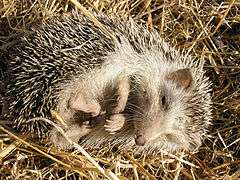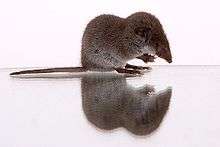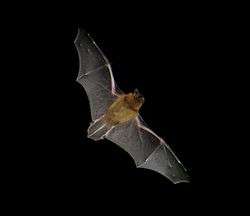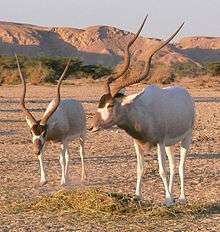List of mammals of Morocco
This is a list of the mammal species recorded in Morocco.[1]
The following tags are used to highlight each species' conservation status as assessed by the International Union for Conservation of Nature:
| EX | Extinct | No reasonable doubt that the last individual has died. |
| EW | Extinct in the wild | Known only to survive in captivity or as a naturalized populations well outside its previous range. |
| CR | Critically endangered | The species is in imminent risk of extinction in the wild. |
| EN | Endangered | The species is facing an extremely high risk of extinction in the wild. |
| VU | Vulnerable | The species is facing a high risk of extinction in the wild. |
| NT | Near threatened | The species does not meet any of the criteria that would categorise it as risking extinction but it is likely to do so in the future. |
| LC | Least concern | There are no current identifiable risks to the species. |
| DD | Data deficient | There is inadequate information to make an assessment of the risks to this species. |
Subclass: Theria
Infraclass: Eutheria
Order: Macroscelidea (elephant shrews)
Often called sengis, the elephant shrews or jumping shrews are native to Africa. Their common English name derives from their elongated flexible snout, which is vaguely similar to the trunk of an elephant (to whom they are distantly related) and their resemblance to the true shrews.
- Family: Macroscelididae (elephant shrews)
- Genus: Elephantulus
- North African elephant shrew, Elephantulus rozeti LC
- Genus: Elephantulus
Order: Primates
The order Primates contains humans and their closest relatives: lemurs, lorisoids, tarsiers, monkeys, and apes.
- Suborder: Haplorhini
- Infraorder: Simiiformes
- Parvorder: Catarrhini
- Superfamily: Cercopithecoidea
- Family: Cercopithecidae (Old World monkeys)
- Subfamily: Cercopithecinae
- Genus: Macaca
- Barbary macaque, M. sylvanus EN[2]
- Genus: Macaca
- Subfamily: Cercopithecinae
- Family: Cercopithecidae (Old World monkeys)
- Superfamily: Cercopithecoidea
- Parvorder: Catarrhini
- Infraorder: Simiiformes
Order: Rodentia (rodents)

Rodents make up the largest order of mammals, with over 40% of mammalian species. They have two incisors in the upper and lower jaw which grow continually and must be kept short by gnawing. Most rodents are small though the capybara can weigh up to 45 kg (99 lb).
- Suborder: Hystricognathi
- Family: Hystricidae (Old World porcupines)
- Subfamily: Hystricinae
- Genus: Hystrix
- Crested porcupine, H. cristata LC[3]
- Genus: Hystrix
- Subfamily: Hystricinae
- Family: Hystricidae (Old World porcupines)
- Suborder: Sciurognathi
- Family: Sciuridae (squirrels)
- Subfamily: Xerinae
- Tribe: Xerini
- Genus: Atlantoxerus
- Barbary ground squirrel, Atlantoxerus getulus LC
- Genus: Xerus
- Striped ground squirrel, Xerus erythropus LC
- Genus: Atlantoxerus
- Tribe: Xerini
- Subfamily: Xerinae
- Family: Dipodidae (jerboas)
- Subfamily: Dipodinae
- Genus: Jaculus
- Lesser Egyptian jerboa, Jaculus jaculus LC
- Greater Egyptian jerboa, Jaculus orientalis LC
- Genus: Jaculus
- Subfamily: Dipodinae
- Family: Gliridae (dormice)
- Subfamily: Leithiinae
- Genus: Eliomys
- Maghreb garden dormouse, Eliomys munbyanus LC
- Genus: Eliomys
- Subfamily: Leithiinae
- Family: Muridae (mice, rats, gerbils)
- Subfamily: Deomyinae
- Genus: Acomys
- Cairo spiny mouse, Acomys cahirinus LC
- Chudeau's spiny mouse, Acomys chudeaui LC
- Genus: Acomys
- Subfamily: Gerbillinae
- Genus: Dipodillus
- North African gerbil, Dipodillus campestris LC
- Genus: Gerbillus
- Lesser Egyptian gerbil, Gerbillus gerbillus LC
- Pygmy gerbil, Gerbillus henleyi LC
- Western gerbil, Gerbillus hesperinus EN
- Hoogstraal's gerbil, Gerbillus hoogstraali VU
- Greater short-tailed gerbil, Gerbillus maghrebi LC
- Balochistan gerbil, Gerbillus nanus LC
- Occidental gerbil, Gerbillus occiduus DD
- Lesser short-tailed gerbil, Gerbillus simoni LC
- Tarabul's gerbil, Gerbillus tarabuli LC
- Genus: Meriones
- Sundevall's jird, Meriones crassus LC
- Moroccan jird, Meriones grandis LC
- Libyan jird, Meriones libycus LC
- Shaw's jird, Meriones shawi LC
- Genus: Pachyuromys
- Fat-tailed gerbil, Pachyuromys duprasi LC
- Genus: Psammomys
- Fat sand rat, Psammomys obesus LC
- Genus: Dipodillus
- Subfamily: Murinae
- Genus: Apodemus
- Wood mouse, Apodemus sylvaticus LC
- Genus: Lemniscomys
- Barbary striped grass mouse, Lemniscomys barbarus LC
- Genus: Mastomys
- Guinea multimammate mouse, Mastomys erythroleucus LC
- Genus: Mus
- House mouse, Mus musculus LC
- Algerian mouse, Mus spretus LC
- Genus: Rattus
- Genus: Apodemus
- Subfamily: Deomyinae
- Family: Ctenodactylidae
- Genus: Ctenodactylus
- Common gundi, Ctenodactylus gundi LC
- Val's gundi, Ctenodactylus vali DD
- Genus: Ctenodactylus
- Family: Sciuridae (squirrels)
Order: Lagomorpha (lagomorphs)

The lagomorphs comprise two families, Leporidae (hares and rabbits), and Ochotonidae (pikas). Though they can resemble rodents, and were classified as a superfamily in that order until the early 20th century, they have since been considered a separate order. They differ from rodents in a number of physical characteristics, such as having four incisors in the upper jaw rather than two.
- Family: Leporidae (rabbits, hares)
- Genus: Lepus
- Cape hare, L. capensis LC[5]
- Granada hare, L. granatensis LC[6]
- African savanna hare, Lepus microtis LC
- Genus: Oryctolagus
- European rabbit, O. cuniculus NT[7]
- Genus: Lepus
Order: Erinaceomorpha (hedgehogs and gymnures)
The order Erinaceomorpha contains a single family, Erinaceidae, which comprise the hedgehogs and gymnures. The hedgehogs are easily recognised by their spines while gymnures look more like large rats.
- Family: Erinaceidae (hedgehogs)
- Subfamily: Erinaceinae
- Genus: Atelerix
- North African hedgehog, A. algirus LC[8]
- Genus: Paraechinus
- Desert hedgehog, P. aethiopicus LC
- Genus: Atelerix
- Subfamily: Erinaceinae
Order: Soricomorpha (shrews, moles, and solenodons)
The "shrew-forms" are insectivorous mammals. The shrews and solenodons closely resemble mice while the moles are stout bodied burrowers.
- Family: Soricidae (shrews)
- Subfamily: Crocidurinae
- Genus: Crocidura
- Mauritanian shrew, Crocidura lusitania LC
- Greater white-toothed shrew, Crocidura russula LC
- Saharan shrew, Crocidura tarfayensis DD
- Savanna path shrew, Crocidura viaria LC
- Whitaker's shrew, Crocidura whitakeri LC
- Genus: Suncus
- Etruscan shrew, Suncus etruscus LC
- Genus: Talpa
- Spanish mole, Talpa occidentalis CR
- Genus: Crocidura
- Subfamily: Crocidurinae
Order: Chiroptera (bats)

The bats' most distinguishing feature is that their forelimbs are developed as wings, making them the only mammals capable of flight. Bat species account for about 20% of all mammals.
- Family: Vespertilionidae
- Subfamily: Myotinae
- Genus: Myotis
- Long-fingered bat, M. capaccinii VU[9]
- Geoffroy's bat, Myotis emarginatus LC
- Whiskered bat, Myotis mystacinus LC
- Zenati myotis, Myotis zenatius LC
- Felten's myotis, Myotis punicus DD
- Genus: Myotis
- Subfamily: Vespertilioninae
- Genus: Barbastella
- Barbastelle, Barbastella barbastellus NT
- Genus: Eptesicus
- Serotine bat, Eptesicus serotinus LC
- Genus: Hypsugo
- Savi's pipistrelle, H. savii LC[10]
- Genus: Nyctalus
- Greater noctule bat, N. lasiopterus NT[11]
- Lesser noctule, N. leisleri LC[12]
- Genus: Otonycteris
- Desert long-eared bat, Otonycteris hemprichii LC
- Genus: Pipistrellus
- Egyptian pipistrelle, Pipistrellus deserti LC
- Kuhl's pipistrelle, Pipistrellus kuhlii LC
- Common pipistrelle, Pipistrellus pipistrellus LC
- Rüppell's pipistrelle, Pipistrellus rueppelli LC
- Genus: Plecotus
- Mediterranean long-eared bat, Plecotus kolombatovici LC
- Genus: Barbastella
- Subfamily: Miniopterinae
- Genus: Miniopterus
- Common bent-wing bat, Miniopterus schreibersii NT
- Genus: Miniopterus
- Subfamily: Myotinae
- Family: Rhinopomatidae
- Genus: Rhinopoma
- Lesser mouse-tailed bat, Rhinopoma hardwickei LC
- Greater mouse-tailed bat, Rhinopoma microphyllum LC
- Genus: Rhinopoma
- Family: Molossidae
- Genus: Tadarida
- European free-tailed bat, Tadarida teniotis LC
- Genus: Tadarida
- Family: Nycteridae
- Genus: Nycteris
- Egyptian slit-faced bat, Nycteris thebaica LC
- Genus: Nycteris
- Family: Rhinolophidae
- Subfamily: Rhinolophinae
- Genus: Rhinolophus
- Blasius's horseshoe bat, Rhinolophus blasii NT
- Mediterranean horseshoe bat, Rhinolophus euryale VU
- Greater horseshoe bat, Rhinolophus ferrumequinum NT
- Lesser horseshoe bat, Rhinolophus hipposideros NT
- Mehely's horseshoe bat, Rhinolophus mehelyi VU
- Genus: Rhinolophus
- Subfamily: Hipposiderinae
- Genus: Asellia
- Trident leaf-nosed bat, Asellia tridens LC
- Genus: Hipposideros
- Sundevall's roundleaf bat, Hipposideros caffer LC
- Genus: Asellia
- Subfamily: Rhinolophinae
Order: Cetacea (whales)
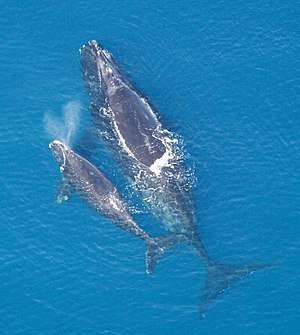
The order Cetacea includes whales, dolphins and porpoises. They are the mammals most fully adapted to aquatic life with a spindle-shaped nearly hairless body, protected by a thick layer of blubber, and forelimbs and tail modified to provide propulsion underwater.
- Suborder: Mysticeti
- Family: Balaenidae (right whales)
- Genus: Eubalaena
- North Atlantic right whale, Eubalaena glacialis CR
- Genus: Eubalaena
- Family: Balaenopteridae (rorquals)
- Genus: Balaenoptera
- Northern minke whale, Balaenoptera acutorostrata LC
- Sei whale, Balaenoptera borealis EN
- Bryde's whale, Balaenoptera edeni DD
- Blue whale, Balaenoptera musculus EN
- Fin whale, Balaenoptera physalus VU
- Genus: Megaptera
- Humpback whale, Megaptera novaengliae LC
- Genus: Balaenoptera
- Family: Balaenidae (right whales)
- Suborder: Odontoceti
- Family: Delphinidae (pilot whales and dolphins)
- Genus: Delphinus
- Short-beaked common dolphin, Delphinus delphis EN
- Genus: Globicephala
- Short-finned pilot whale, Globicephala macrorhynchus DD
- Long-finned pilot whale, Globicephala melas DD
- Genus: Grampus
- Risso's dolphin, Grampus griseus DD
- Genus: Lagenodelphis
- Fraser's dolphin, Lagenodelphis hosei LC
- Genus: Orcinus
- Orca, Orcinus orca DD
- Genus: Pseudorca
- False killer whale, Pseudorca crassidens DD
- Genus: Feresa
- Pygmy killer whale, Feresa attenuata DD
- Genus: Stenella
- Striped dolphin, Stenella coeruleoalba VU
- Atlantic spotted dolphin, Stenella frontalis DD
- Genus: Steno
- Rough-toothed dolphin, Steno bredanensis LC
- Genus: Tursiops
- Common bottlenose dolphin, Tursiops truncatus VU
- Genus: Delphinus
- Family: Kogiidae (small sperm whales)
- Genus: Kogia
- Pygmy sperm whale, Kogia breviceps DD
- Dwarf sperm whale, Kogia sima DD
- Genus: Kogia
- Family: Phocoenidae (porpoises)
- Genus: Phocoena
- Harbour porpoise, Phocoena phocoena LC
- Genus: Phocoena
- Family: Physeteridae (sperm whales)
- Genus: Physeter
- Sperm whale, Physeter macrocephalus EN
- Genus: Physeter
- Family: Ziphiidae (beaked whales)
- Genus: Hyperoodon
- Northern bottlenose whale, Hyperoodon ampullatus DD
- Genus: Mesoplodon
- Sowerby's beaked whale, Mesoplodon bidens DD
- Blainville's beaked whale, Mesoplodon densirostris DD
- Gervais' beaked whale, Mesoplodon europaeus DD
- True's beaked whale, Mesoplodon mirus DD
- Genus: Ziphius
- Cuvier's beaked whale, Ziphius cavirostris DD
- Genus: Hyperoodon
- Family: Delphinidae (pilot whales and dolphins)
Order: Carnivora (carnivorans)





There are over 260 species of carnivorans, the majority of which feed primarily on meat. They have a characteristic skull shape and dentition.
- Suborder: Feliformia
- Family: Felidae (cats)
- Subfamily: Felinae
- Genus: Felis
- Sand cat, Felis margarita LC[13]
- African wildcat, Felis lybica LC
- Genus: Caracal
- Caracal, C. caracal LC
- Genus: Leptailurus
- Genus: Felis
- Subfamily: Pantherinae
- Genus: Panthera
- Leopard, P. pardus VU[15]
- African leopard, P. p. pardus
- Leopard, P. pardus VU[15]
- Genus: Panthera
- Subfamily: Felinae
- Family: Viverridae
- Subfamily: Viverrinae
- Genus: Genetta
- Common genet, G. genetta LC[16]
- Genus: Genetta
- Subfamily: Viverrinae
- Family: Herpestidae (mongooses)
- Genus: Herpestes
- Egyptian mongoose, H. ichneumon LC[17]
- Genus: Herpestes
- Family: Hyaenidae (hyaenas)
- Genus: Hyaena
- Striped hyena, H. hyaena VU
- Genus: Hyaena
- Family: Felidae (cats)
- Suborder: Caniformia
- Family: Canidae (dogs, foxes)
- Genus: Vulpes
- Red fox, V. vulpes LC[18]
- Rüppell's fox, V. rueppelli LC
- Fennec fox, V. zerda LC
- Genus: Canis
- African golden wolf, C. anthus
- Genus: Vulpes
- Family: Mustelidae (mustelids)
- Genus: Mustela
- European polecat, M. putorius LC
- Least weasel, M. nivalis LC
- Genus: Ictonyx
- Saharan striped polecat, I. libyca LC
- Genus: Mellivora
- Honey badger, M. capensis LC[19]
- Genus: Lutra
- European otter, L. lutra NT[20]
- Genus: Mustela
- Family: Phocidae (earless seals)
- Genus: Monachus
- Mediterranean monk seal, M. monachus EN[21]
- Genus: Monachus
- Family: Canidae (dogs, foxes)
Order: Hyracoidea (hyraxes)

The hyraxes are any of four species of fairly small, thickset, herbivorous mammals in the order Hyracoidea. About the size of a domestic cat they are well-furred, with rounded bodies and a stumpy tail. They are native to Africa and the Middle East.
- Family: Procaviidae (hyraxes)
- Genus: Procavia
- Cape hyrax, Procavia capensis CR
- Genus: Procavia
Order: Artiodactyla (even-toed ungulates)

The even-toed ungulates are ungulates whose weight is borne about equally by the third and fourth toes, rather than mostly or entirely by the third as in perissodactyls. There are about 220 artiodactyl species, including many that are of great economic importance to humans.
- Family: Suidae (pigs)
- Subfamily: Suinae
- Genus: Sus
- Wild boar, S. scrofa LC[22]
- North African boar, Sus scrofa algira
- Wild boar, S. scrofa LC[22]
- Genus: Sus
- Subfamily: Suinae
- Family: Camelidae (camels, llamas)
- Family: Cervidae (deer)
- Subfamily: Cervinae
- Genus: Cervus
- Red deer, C. elaphus LC [23]
- Barbary stag, C. e. barbarus
- Red deer, C. elaphus LC [23]
- Genus: Cervus
- Subfamily: Cervinae
- Family: Bovidae (cattle, antelope, sheep, goats)
- Subfamily: Antilopinae
- Genus: Gazella
- Cuvier's gazelle, Gazella cuvieri VU
- Dama gazelle, Gazella dama CR
- Dorcas gazelle, Gazella dorcas EN
- Genus: Gazella
- Subfamily: Caprinae
- Genus: Ammotragus
- Barbary sheep, A. lervia VU
- Genus: Ammotragus
- Subfamily: Hippotraginae
- Subfamily: Antilopinae
See also
References
- This list is derived from the IUCN Red List which lists species of mammals and includes those mammals that have recently been classified as extinct (since 1500 AD). The taxonomy and naming of the individual species is based on those used in existing Wikipedia articles as of 21 May 2007 and supplemented by the common names and taxonomy from the IUCN, Smithsonian Institution, or University of Michigan where no Wikipedia article was available.
- Butynski, T. M.; Cortes, J.; Water, S.; Fa, J.; Hobbelink, M. E.; van Lavieren, E.; Belbachir, F.; Cuzin, F.; de Smet, K.; Mouna, M. (2008). "Macaca sylvanus". IUCN Red List of Threatened Species. 2008: e.T12561A3359140.
- Amori, G.; Hutterer, R.; Kryštufek, B.; Yigit, N.; Mitsain, G. & Palomo, L. J. (2016). "Hystrix cristata". IUCN Red List of Threatened Species. 2016: e.T10751A115099509.
- Kryštufek, B.; Palomo, L.J.; Hutterer, R.; Mitsain, G. & Yigit, N. (2015). "Rattus rattus". IUCN Red List of Threatened Species. 2015: e.T19360A115148682.
- Johnston, C. H.; Robinson, T. J.; Child, M. F.; Relton, C. (2019). "Lepus capensis". IUCN Red List of Threatened Species. 2019: e.T41277A45186750.
- Soriguer, R. & Carro, F. (2019). "Lepus granatensis". IUCN Red List of Threatened Species. 2019: e.T41306A2953195.
- Smith, A. T.; Boyer, A. F. (2008). "Oryctolagus cuniculus". IUCN Red List of Threatened Species. 2008: e.T41291A10415170.
- Amori, G.; Hutterer, R.; Kryštufek, B.; Yigit, N.; Mitsain, G. & Palomo, L. J. (2008). "Atelerix algirus". IUCN Red List of Threatened Species. 2008: e.T27926A9481697.CS1 maint: multiple names: authors list (link)
- Hutson, A. M.; Spitzenberger, F.; Aulagnier, S.; Juste, J.; Karatas, A.; Palmeirim, J. & Paunovic, M. (2010). "Myotis capaccinii". IUCN Red List of Threatened Species. 2010: e.T14126A4399043.CS1 maint: multiple names: authors list (link)
- Hutson, A. M.; Spitzenberger, F.; Juste, J.; Aulagnier, S.; Palmeirim, J.; Paunovic, M.; Karatas, A. (2010). "Hypsugo savii". IUCN Red List of Threatened Species. 2010: e.T44856A10955205.
- Hutson, A. M.; Alcaldé, J. T.; Juste, J.; Karataş, A.; Palmeirim, J. & Paunović, M. (2010). "Nyctalus lasiopterus". IUCN Red List of Threatened Species. 2010: e.T14918A4471682.CS1 maint: multiple names: authors list (link)
- Juste, J. & Paunović, M. (2016). "Nyctalus leisleri". IUCN Red List of Threatened Species. 2016: e.T14919A22016159.CS1 maint: multiple names: authors list (link)
- Sliwa, A.; Ghadirian, T.; Appel, A.; Banfield, L.; Sher Shah, M. & Wacher, T. (2016). "Felis margarita". IUCN Red List of Threatened Species. 2016: e.T8541A50651884.
- Thiel, C. (2015). "Leptailurus serval". IUCN Red List of Threatened Species. 2015: e.T11638A50654625.
- Stein, A. B.; Athreya, V.; Gerngross, P.; Balme, G.; Henschel, P.; Karanth, U.; Miquelle, D.; Rostro-Garcia, S.; Kamler, J. F.; Laguardia, A.; Khorozyan, I. & Ghoddousi, A. (2020). "Panthera pardus". IUCN Red List of Threatened Species. 2020: e.T15954A163991139.
- Gaubert, P.; Carvalho, F.; Camps, D. & Do Linh San, E. (2015). "Genetta genetta". IUCN Red List of Threatened Species. 2015: e.T41698A45218636.
- Do Linh San, E.; Maddock, A.H.; Gaubert, P. & Palomares, F. (2016). "Herpestes ichneumon". IUCN Red List of Threatened Species. 2016: e.T41613A45207211.CS1 maint: multiple names: authors list (link)
- Hoffmann, M.; Sillero-Zubiri, C. (2016). "Vulpes vulpes". IUCN Red List of Threatened Species. 2016: e.T23062A46190249.
- Do Linh San, E.; Begg, C.; Begg, K. & Abramov, A. V. (2016). "Mellivora capensis". IUCN Red List of Threatened Species. 2016: e.T41629A4521010.CS1 maint: multiple names: authors list (link)
- Roos, A.; Loy, A.; de Silva, P.; Hajkova, P.; Zemanová, B. (2015). "Lutra lutra". IUCN Red List of Threatened Species. 2015: e.T12419A21935287.
- Karamanlidis, A. & Dendrinos, P. (2015). "Monachus monachus". IUCN Red List of Threatened Species: e.T13653A45227543.
- Keuling, O. & Leus, K. (2019). "Sus scrofa". IUCN Red List of Threatened Species. 2019: e.T41775A44141833.
- Lovari, S.; Lorenzini, R.; Masseti, M.; Pereladova, O.; Carden, R.F.; Brook, S.M. & Mattioli, S. (2018). "Cervus elaphus". IUCN Red List of Threatened Species. 2018: e.T55997072A142404453.
- Aulagnier, S. et al. (2008) Guide des mammifères d'Europe, d'Afrique du Nord et de Moyen-Orient. Delachaux et Niestlé, Paris
- Kingdon, J. (1997) The Kingdon Field Guide to African Mammals. Helm, London
- Shirihai, H. & Jarrett, B. (2006) Whales, Dolphins and Seals: A Field Guide to the Marine Mammals of the World. A & C Black, London
External links
- "Animal Diversity Web". University of Michigan Museum of Zoology. 1995–2006. Retrieved 22 May 2007.





